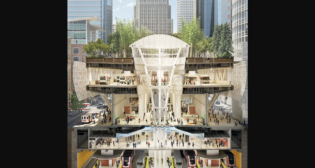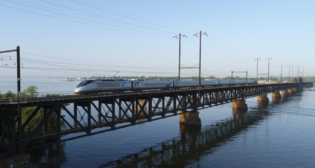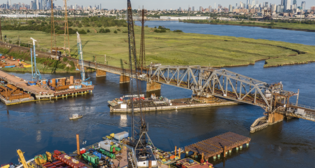
Alabama & Gulf Coast Railway CBR train derails, explodes
Written by William C. Vantuono, Editor-in-ChiefNo injuries occured; the train’s crew walked away from the wreck, as they were protected by the consist’s two buffer cars, which did not derail. According to a Reuters News report, the derailed cars threw flames 300 feet into the night sky and were allowed to burn down, which was expected to take up to 24 hours.
“A local official said the crude oil had originated in North Dakota, home of the booming Bakken shale patch,” Reuters reported. “If so, it may have been carrying the same type of light crude oil that was on a Canadian train that derailed in the Quebec town of Lac-Mégantic this summer, killing 47 people. That accident fueled a drive for tougher standards for oil rail shipments, including better testing of potentially explosive ultra-light shale crude and improved rail tank car standards. Tank cars made before 2011 have been cited by regulators as dangerously prone to puncture.”
Genesee & Wyoming, the parent company of Alabama & Gulf Coast Railway, subsequently affirmed that the train was carrying North Dakota crude. But GWI also stressed that the incident was not a repeat of the derailment and explosion in Lac-Megantic, Quebec, on July 6, 2013, which killed 47.
“It was not clear what caused the accident, nor how old the cars on the [Alabama & Gulf Coast Railway] train were. The train was being operated by two engineers, both unharmed,” officials said, according to Reuters.
“While Friday’s accident in Pickens County, Ala., did not seem to pose major environmental risk, it still appeared to be the most dramatic of its kind in the United States since trafficking of crude by rail began to increase with the growth of shale oil production three years ago.
“‘It will provide very clear evidence of the potential risks for environmental groups and others opposed to the growth of crude by rail, and will likely increase pressure to tighten regulations,’ said Elena McGovern, Global Energy and Natural Resources analyst at Eurasia Group in Washington.
“Traders said they feared that tougher regulations could drive up costs for shipping U.S. crude by rail, reducing its competitiveness. Such speculation weakened U.S. crude oil futures relative to London’s benchmark Brent, which already trades at a premium to the price in New York.
“The G&W spokesman said the train was carrying crude from Amory, Miss., to Walnut Hill, Fla. Trade sources said it was likely headed to a large terminal, after which it may have been intended for pipelines or barges for delivery to a Gulf Coast refinery.
“Don Hartley, regional coordinator for the Alabama Emergency Management Agency, said the tank cars originated in North Dakota. Three cars had a “‘bleve’—where pressure builds up and blows a hole.’ That started the fire, he said. Crude oil did spill on Friday, though it does not appear to be heading to nearby waterways, G&W said. Alabama Emergency Management Agency spokeswoman Yasamie August said that one family was evacuated due to the incident, but had already been able to return home.
“So far there are no details on the cause. ‘We don’t have a cause yet, that will be determined with the investigation,’ said a G&W spokesman. The company said it had notified the National Transportation Safety Board, Federal Railroad Administration, and National Crisis Response Center per standard procedure.
“Rapid proliferation of [CBR] shipments started more than three years ago to get oil to markets as pipeline infrastructure lagged booming production in remote places like North Dakota, as well as Canada’s oil sands. The East and West coasts in particular turned to rail to draw cheaper U.S. and Canadian crude. With no major oil pipelines in operation, or even planned, rail allowed them to tap into the burgeoning shale plays in North Dakota and Texas. In the third quarter, CBR shipments rose 44% from the previous year to 93,312 carloads, equivalent to about 740,000 barrels per day (bpd) or almost one-tenth of U.S. production. That was down 14% from the second quarter due to narrower oil spreads that made costlier rail shipments less economic.
“The NTSB has issued safety guidelines on the widely used, cylindrical tank cars known as DOT-111s, including a recommendation that all tank cars used to carry ethanol and crude oil be reinforced to make them more resistant to punctures if a train derails. The new guidelines, put forward in March 2012 but which have not yet been adopted by the [Federal Railroad Administration], stem from a deadly ethanol train derailment and explosion in Illinois in 2009.”
DOT-111 tank cars ordered after October 2011 have been manufactured to new safety standards developed jointly by the railroads and tank car manufacturers, “but the industry has resisted spending an estimated $1 billion to retrofit nearly 300,000 existing tank cars,” the Reuters report said.



